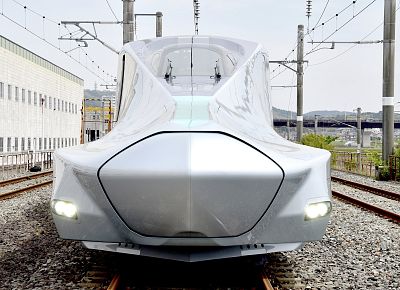Passengers will be able to travel 680 miles, from Tokyo and Sapporo, in less than four hours.
The picture of a "bullet train" speeding past Mount Fuji is an iconic image of modern Japan.
In recent years, however, Japan has lost the "world's fastest train" title to China — if only by a few miles per hour. But now, Japan plans to reclaim that crown, with a new bullet train that will whisk between cities with journey times that rival passenger jets.
The Alfa-X train, unveiled by rail company JR East, will carry passengers at up to 224 miles per hour, outpacing the fastest Japanese bullet trains in commercial service today by almost 25 miles per hour.
At that speed, the 680-mile journey between Tokyo and Sapporo, the largest city in the northern Hokkaido region, will take less than four hours. That's around half the time it takes today, thanks to a new high-speed railway line that is set to open between the two cities in 2030, when the Alfa-X trains will go into service.
The Alfa-X will be tested over the next three years at speeds of up to 249 miles per hour between the cities of Amori and Sendai — but only at night, when regular trains aren't running, according to a statement from JR East.
The $91 million test train has 10 cars and is driven by powerful electric motors in the first and the last cars that draw their power from overhead wires. These two cars will be tested with elongated nosecones, extending up to 72 feet long, that reduce the loud booming noise created when the train travels into a tunnel.
But stopping a train quickly is as important as speed, so the Alfa-X is equipped with aerodynamic "drag plates" for emergency air-braking at high speeds, as well as electro-magnetic brakes on the wheels.
Technology
The train also has a new suspension system designed to keep it stable if there's an earthquake, and an ultramodern cockpit for the driver.
"We want to improve not only speed, but also safety and comfort," project leader Ichiro Ogawa, who heads research and development for JR East, told the Japanese newspaper The Mainichi.
Chris Jackson, the editor-in-chief of Railway Gazette International, based in London, said JR East wanted to raise their maximum train speed to 224 miles per hour to achieve a journey time between Tokyo to Sapporo that rivals flying.
Currently, the world's fastest trains in regular service run between Beijing and Shanghai, in China, at speeds up to 217 miles an hour, he said.
#embed-20190516-fastest-trains iframe {width: 1px;min-width: 100%}
Even faster trains are proposed for Japan. A 220-mile track for trains using magnetic levitation, or "maglev," instead of conventional wheels, is due to open in 2027 between Tokyo and Nagoya.
The Japanese maglev trains would run at speeds of up to 310 miles per hour, cutting what is now a 110-minute journey time to just 40 minutes.
Until then, the world's only commercial maglev train operates on a dedicated 19-mile track that runs from the outskirts of Shanghai to one of the city's airports. It reaches a top speed of 267 miles per hour, but the $1.2 billion cost of building it has dwarfed ticket revenues from the service, The Guardian reported in 2018.
In the United States, debate continues over the importance of fast trains.
America's fastest train, Amtrak's Acela Express, reaches a top speed of 150 miles per hour between Boston and Washington, D.C, although the train runs at that speed for only 34 miles of the 450-mile route.
Michael Smart, a professor of planning and public policy at Rutgers University in New Brunswick, New Jersey, explained that the railway networks in the United States have been heavily used — but predominantly by freight trains, rather than passenger trains.
"While the rewards — environmental, social and political — of a successful high-speed rail corridor could be quite large," Smart said, "the political risks are also immense."
Want more stories about the future of travel?
- Goodyear unveils flying car tire concept that works on the ground and in the air
- World's first 'floating tunnel' could be built in Norway
- Hypersonic air travel just took a step closer to reality
SIGN UP FOR THE MACH NEWSLETTER AND FOLLOW NBC NEWS MACH ON TWITTER, FACEBOOK, AND INSTAGRAM.












